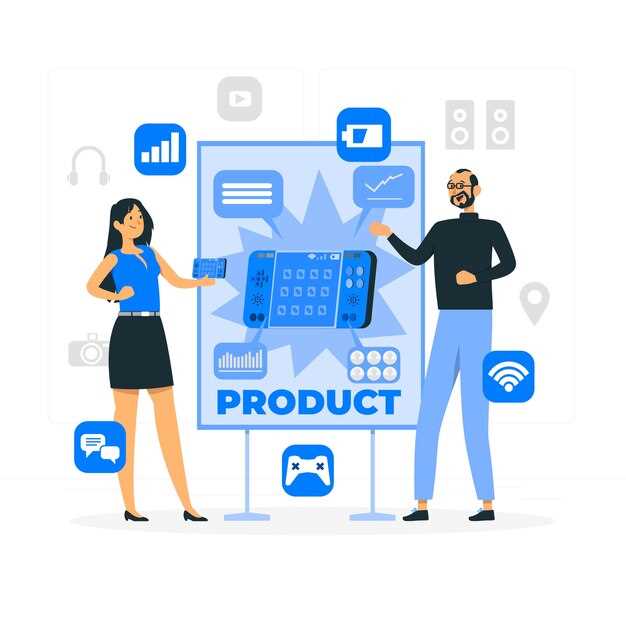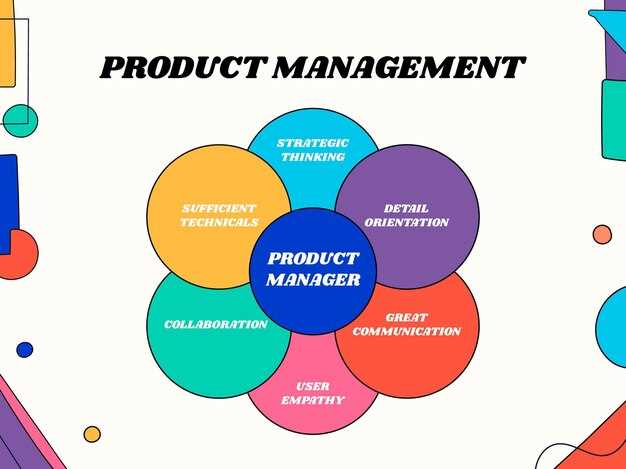Implement Scrum for your next project. This framework breaks work into sprints, allowing teams to deliver increments of the product with greater speed and flexibility. Sprints typically last two to four weeks, helping teams consistently review progress and adjust priorities based on feedback.
Consider Kanban for ongoing projects where priorities may shift rapidly. This visual approach allows for real-time tracking of tasks in a continuous workflow. Use a Kanban board to identify bottlenecks and optimize the flow of work. This technique encourages transparency and accountability among team members.
Lean principles can also enhance product development by focusing on maximizing value while minimizing waste. Regularly assess your workflows to eliminate unnecessary steps, ensuring that every effort directly contributes to the customer’s needs. Establish a culture of continuous improvement, where team members actively seek ways to enhance processes.
Incorporate regular retrospectives to reflect on what worked and what didn’t. This practice promotes a growth mindset within the team, allowing for adjustments that enhance collaboration and productivity. By fostering an environment where feedback is welcomed, you can drive innovation and efficiency in product delivery.
Lastly, prioritize user feedback throughout the development cycle. Engage with customers early and often to validate assumptions and iterate on the product. This approach ensures that the end result aligns with user expectations and market demands, ultimately leading to a more successful product launch.
Understanding Agile Development Principles in Practice

Focus on delivering value through iterative development. Break down projects into manageable increments, allowing teams to quickly respond to changes and refine the project based on feedback.
Key Principles to Implement
- Prioritize Customer Collaboration: Regularly engage with stakeholders to ensure their needs shape the development process. Use tools like user stories to capture and prioritize requirements effectively.
- Maintain a Sustainable Pace: Encourage teams to work at a consistent, sustainable rate. Overloading teams can lead to burnout and decreased productivity.
- Embrace Change: View changing requirements as opportunities to enhance the product. Implement mechanisms to incorporate feedback swiftly, adjusting priorities as needed.
- Deliver Working Software Frequently: Aim to release functional software at regular intervals. This builds trust and keeps stakeholders involved and informed.
Practical Techniques to Enhance Agile Implementation
- Use Daily Stand-ups: Conduct short daily meetings to discuss progress, obstacles, and goals. This keeps everyone aligned and promotes accountability.
- Implement Retrospectives: Regularly reflect on the team’s processes and outcomes. Identify what works, what doesn’t, and how to improve continuously.
- Visualize Work: Use boards (physical or digital) to visualize work in progress. This transparency helps teams stay organized and focused on priorities.
Apply these principles and techniques consistently for better outcomes in digital product development. Building a culture of collaboration and adaptability will lead to products that meet user needs more effectively.
Key Differences Between Agile and Traditional Project Management

Focus on flexibility and collaboration defines Agile practices, while Traditional Project Management emphasizes linear processes and strict adherence to plans. Understand these differences to select the right methodology for your project.
- Structure: Traditional methods often follow a defined sequential process (Waterfall), tightly controlling project phases. Agile opts for iterative cycles, allowing adjustments at short intervals.
- Planning: In Traditional Management, detailed upfront planning sets the course. Agile promotes continuous planning, adapting to new information and changes throughout the project lifecycle.
- Team Dynamics: Traditional approaches rely on defined roles and hierarchies. Agile encourages cross-functional teams, enhancing collaboration and knowledge sharing, which leads to faster problem-solving.
- Customer Involvement: Traditional methods engage customers mainly at project start and finish. Agile incorporates customer feedback regularly, ensuring the product meets expectations and evolves based on user needs.
- Change Management: Traditional Project Management often views changes as disruptive, making adjustments difficult. Agile embraces change, welcoming new requirements even late in development.
- Delivery: Traditional frameworks deliver the final product after completing all phases. Agile promotes incremental delivery, enabling users to receive and test components throughout development.
Choosing the right approach hinges on project requirements, team structure, and customer expectations. Use this understanding to align your management strategy effectively.
Benefits of Adopting Agile in Digital Product Teams

Adopt Agile practices to enhance collaboration within your digital product team. Regular stand-up meetings encourage communication, fostering a sense of shared responsibility and ensuring everyone is aligned on project goals.
Incorporate iterative development for quicker feedback. Short sprints allow teams to release prototypes and gather user input promptly. This approach helps identify areas for improvement early, reducing costly revisions later.
Enhance adaptability by prioritizing tasks based on customer value. Agile methodologies emphasize responding to changes in user requirements, enabling teams to focus on delivering features that matter most to end-users.
Encourage cross-functional team structures to leverage diverse skills. By integrating developers, designers, and marketers, your team can address challenges from various perspectives, leading to innovative solutions and a more cohesive product.
Measure progress through transparent metrics. Use Kanban boards or burndown charts to visualize workflow and track performance. This transparency helps identify bottlenecks and facilitates proactive problem-solving.
Promote a culture of continuous improvement. Conduct regular retrospectives to reflect on what works well and what can be optimized. This practice cultivates a mindset of growth and encourages team members to contribute to enhancing processes.
Finally, invest in team autonomy. Empower individuals to make decisions related to their work, boosting morale and encouraging accountability. This ownership fosters a motivated environment where team members take pride in the product they create.
Creating a Product Backlog: Best Practices and Tips

Prioritize user stories based on value and complexity. Use a simple scale to assess features, allowing the team to focus on delivering what matters most first. Collaboration with stakeholders ensures alignment on priorities. Regularly revisiting priorities keeps the backlog relevant as new information arises.
Break down larger features into smaller, manageable tasks. This facilitates clearer understanding and quicker delivery. Aim for items that can be completed within a single sprint, making it easier to track progress and adjust plans as needed.
Involve the entire team in backlog refinement sessions. Including developers, testers, and designers contributes to diverse perspectives, leading to more robust planning. These sessions should occur regularly, allowing the team to discuss and clarify user stories and estimates.
Keep descriptions clear and concise. A well-written user story follows the “As a [user], I want [goal] so that [reason]” format, helping everyone understand the value and intent behind the tasks. Avoid jargon that could confuse team members or stakeholders.
Incorporate feedback loops by regularly engaging with users. Gathering insights from actual users influences backlog items directly, ensuring the product meets their needs. Adjust and refine based on this feedback to enhance user satisfaction.
Utilize tools that fit your team’s workflow. Whether it’s a physical board or a digital tool, find a system that is easy to use and promotes collaboration. Transparency within the backlog fosters accountability and motivates the team.
Maintain a balance between new features and technical debt. Addressing technical debt ensures the product remains maintainable and scalable. Set aside time in each sprint for improvement tasks, keeping the product pipeline healthy.
Document rationale for removing or reprioritizing items. This provides team members with context for decisions and helps maintain a shared understanding of the product vision. Regularly revisiting the backlog ensures it reflects the current goals of the project.
Effective Sprint Planning for Maximum Output
Begin with clear objectives. Define what needs to be accomplished during the sprint by choosing user stories or tasks based on priority and team capacity. Use the MoSCoW method–categorizing requirements into Must have, Should have, Could have, and Won’t have–helps clarify these objectives.
Engage the Entire Team
Involve all team members during planning sessions. This promotes ownership and fosters collaboration. Everyone should voice their insights on task estimation and dependencies. Use planning poker for estimating story points, ensuring each team member contributes to the discussion without bias.
- Facilitate open dialogue to surface potential blockers early.
- Allow team members to challenge estimates to refine understanding.
Prioritize and Refine Backlog
Regularly refine the product backlog to maintain focus on high-value items. Conduct backlog grooming sessions before sprint planning. Assess which items provide the most significant impact or are closest to completion.
- Review feedback from previous sprints to adjust priorities.
- Ensure each backlog item has clear acceptance criteria.
- Limit scope creep by avoiding the addition of new tasks during the sprint.
Allocate time for team reflection post-sprint to evaluate what succeeded and what didn’t. Identify areas for improvement in future planning sessions. Establishing a rhythm for sprint planning enhances predictability and output quality, leading to a streamlined development process.
Role of the Scrum Master in Streamlining Workflows
The Scrum Master actively removes obstacles that hinder the team’s progress. By facilitating open communication, they help teams identify roadblocks early and encourage quick resolutions. Regular check-ins and feedback loops promote transparency and trust, allowing issues to be addressed promptly.
Empowering the team is a key aspect of the Scrum Master’s role. They enable team members to take ownership of their tasks, fostering accountability and collaboration. This empowerment enhances productivity and nurtures a culture of proactive problem-solving.
The Scrum Master organizes and leads Scrum ceremonies–sprint planning, daily stand-ups, sprint reviews, and retrospectives. These meetings create structured touchpoints for alignment and reflection, ensuring everyone is on the same page and focused on shared goals. Tailoring these ceremonies to fit the team’s unique dynamics can lead to smoother workflows.
Continuous improvement is a priority for the Scrum Master. By encouraging the team to assess their processes and outcomes regularly, they help identify areas for enhancement. Implementing small, incremental changes often leads to significant increases in efficiency over time.
Coaching the team on Scrum principles equips them with the knowledge to effectively utilize the framework. The Scrum Master clarifies roles and responsibilities, ensuring each team member understands their contribution to the project. This clarity minimizes confusion and streamlines collaborations.
Building strong relationships with stakeholders is crucial. The Scrum Master acts as a bridge, facilitating communication between the development team and external parties. Keeping stakeholders informed helps manage expectations and align priorities, which contributes to smoother project dynamics.
By championing a culture of feedback, the Scrum Master nurtures an environment where team members feel comfortable sharing insights and suggestions. This ongoing dialogue leads to continuous refinements in processes and a more agile response to changing requirements.
Incorporating metrics to track team performance enables the Scrum Master to identify trends and areas in need of attention. These quantifiable insights support objective decision-making and foster a results-driven mindset within the team.
Kanban: Visualizing Tasks for Enhanced Clarity
Implement Kanban boards to track tasks visually and improve communication among team members. Use columns for different stages of task completion, such as “To Do,” “In Progress,” and “Done.” This structure enables everyone to understand the status of each task at a glance.
Creating Your Kanban Board
Start by defining the workflow steps. Tailor them to fit your team’s process, ensuring clarity on each stage. Use sticky notes or digital tools like Trello or Jira for easy adjustments and updates. Here’s a simple table to guide you in setting up a basic Kanban board:
| Column | Description |
|---|---|
| To Do | Tasks that need to be started. |
| In Progress | Tasks currently being worked on. |
| Review | Completed tasks under review. |
| Done | Finished tasks. |
Limit Work in Progress
Set limits on the number of tasks allowed in each column. This practice helps maintain focus and prevents team members from becoming overwhelmed. For instance, allowing only three tasks in the “In Progress” column encourages prioritization and accountability. Regularly review the board during stand-up meetings to ensure tasks move through the pipeline smoothly.
Encourage team members to update task statuses as they progress. This ongoing visibility not only fosters teamwork but also helps identify bottlenecks early on. By adapting the board to capture relevant metrics, you can analyze team performance and streamline processes continuously.
Measuring Success: Metrics for Agile Project Management
Track your progress using specific metrics that reflect team performance and product quality. One key metric is the Velocity, which measures the amount of work completed in a sprint. Calculate it by summing up the story points finished during that sprint. This allows teams to predict future sprint capacities effectively.
Lead Time measures the time from the moment a new task is created until it is completed. Shortening lead time indicates improved efficiency and responsiveness to customer needs. Regularly review this metric to identify bottlenecks in your workflow.
Another important metric is Cumulative Flow Diagram (CFD). It visualizes the status of work items over time, showing how many are in progress, completed, or waiting to be started. Analyze changes in the flow to recognize areas needing attention.
Focus on Customer Satisfaction as a qualitative metric. Use surveys and feedback tools to gauge user sentiment post-release. Improvements in customer feedback can signal successful iterations and alignment with user needs.
Keep an eye on the Burndown Chart, which visualizes the remaining work against the time allotted for the sprint. A steady decline in tasks indicates a well-functioning team, while flat lines can highlight issues with progress.
Finally, consider team morale through Retrospective Feedback. Regularly collect insights on team dynamics and performance, fostering a culture of continuous improvement. Happy teams are often more productive, leading to better project outcomes.
Integrating User Feedback into Agile Development Cycles
Begin each development cycle with a feedback collection phase. Use tools like surveys or focus groups to gather insights from users on existing features and their needs. By positioning this phase early, your team can make informed decisions that align with user expectations.
Incorporate user feedback into sprint planning meetings. Prioritize feedback by assessing its impact on user satisfaction and product goals. Utilize a simple scoring system to categorize feedback based on urgency and relevance:
| Feedback Category | Description | Action Level |
|---|---|---|
| High Impact | Feedback that significantly enhances user experience | Immediate Action |
| Moderate Impact | Suggestions that improve functionality or usability | Plan for Future Sprints |
| Low Impact | Minor tweaks or cosmetic changes | Consider Later |
Adopt a continuous feedback loop. After each sprint, conduct retrospectives focused on user feedback. Discuss what changes were made and how they affected user experience. This practice not only enhances team visibility but also keeps user perspectives at the forefront of your development efforts.
Implement A/B testing to validate assumptions. For new features, create multiple variations and test them with a portion of your user base. Analyzing user interactions will guide decisions on which version to launch broadly.
Leverage analytics tools to track user behavior. Metrics such as bounce rates or feature usage provide quantifiable data to supplement qualitative feedback. By merging these insights, you’ll form a clearer picture of user preferences and pain points.
Encourage ongoing communication with users. Set up channels for feedback during product usage. Regular check-ins or user interviews after significant updates help maintain a relationship and deepen understanding of user context.
Reflect on feedback implementation during sprint reviews. Share successes and areas for improvement linked to user feedback to reinforce its value among team members. This practice can boost motivation and create a user-centered culture within the team.
Regularly iterate on your feedback processes. Analyze the effectiveness of feedback collection methods and adapt them based on changing user needs and project requirements. Staying flexible ensures that your development cycle aligns with real user feedback every step of the way.
Scaling Agile Methodologies for Larger Projects
Adopt a framework like the Scaled Agile Framework (SAFe) to structure your larger projects. SAFe integrates principles from Lean, Agile, and product development flow to address the challenges of scaling. Use its layers, including Team, Program, and Portfolio, to align multiple teams towards common goals.
Establish Cross-Functional Teams
Form cross-functional teams that include members with varied expertise–developers, designers, and quality assurance professionals. This diversity enhances collaboration and accelerates issue resolution. Encourage regular team interactions through ceremonies like sprint planning and daily stand-ups.
Implement Continuous Integration and Continuous Deployment (CI/CD)
Integrate CI/CD practices to streamline development and deployment. Automate testing to ensure quality at every stage. This approach allows teams to rapidly deliver updates while maintaining stability in large codebases.
- Choose tools that support automated testing and integration.
- Regularly review and refine your CI/CD pipelines for efficiency.
- Encourage feedback loops to identify bottlenecks early.
Track progress with metrics tailored to team performance and project goals. Use metrics such as lead time, cycle time, and team velocity to assess productivity and quality. Regular retrospectives can help teams identify improvement areas and adapt their practices accordingly.
Maintain alignment with stakeholders through consistent communication. Set up regular alignment meetings to review progress and adjust priorities. Encourage transparency by sharing work in progress and outcomes for collective insight.
Foster a culture of learning and adaptation. Encourage teams to experiment with practices that suit their context. Support training programs and knowledge-sharing sessions to keep skills current and promote innovation across teams.
Common Challenges and Solutions in Agile Implementation
Prioritize clear communication. Misunderstandings often arise from vague requirements. Establish regular meetings to discuss progress and issues. Use visual tools like Kanban boards to represent workflows and tasks clearly. This transparency fosters collaboration.
Address team resistance. Some team members may feel uncomfortable with the shift to Agile. Facilitate workshops to explain Agile principles and benefits. Encourage participation in decision-making to increase buy-in and enthusiasm.
Manage changing requirements. Agile welcomes change, but it can lead to chaos. Implement strict change control processes. Use backlog refinement sessions to review and prioritize changes regularly. This process helps maintain focus while accommodating necessary adjustments.
Ensure adequate training. Insufficient knowledge of Agile practices can hinder success. Provide ongoing training sessions tailored to the team’s specific roles. Consider pairing experienced team members with newcomers for mentoring, promoting skill development and confidence.
Maintain stakeholder engagement. Lack of involvement from stakeholders can disrupt the feedback loop. Involve them in sprint reviews and retrospectives. Encourage their input throughout the development cycle to ensure alignment with business goals and user needs.
Measure progress meaningfully. Relying solely on velocity metrics may mislead teams. Combine qualitative and quantitative measures, such as customer satisfaction and defect rates, to assess success comprehensively. Adjust practices based on these insights for continuous improvement.
Facilitate cross-functional collaboration. Siloed teams can limit effectiveness. Create cross-functional teams that bring together different expertise. Foster an environment where team members collaborate on problem-solving, enhancing creativity and efficiency in addressing challenges.
Allocate time for retrospectives. Neglecting retrospectives can stall improvement. Dedicate time at the end of each sprint for reflection. Encourage open discussion about what worked and what didn’t, creating actionable items for future sprints. This reinforces a culture of learning.
Tools and Software for Supporting Agile Practices
Start using tools that facilitate collaboration and transparency within your team. Tools like Jira and Trello provide robust frameworks for managing tasks and projects, allowing teams to visualize their workflow and prioritize effectively. Jira is particularly useful for tracking sprints, managing backlogs, and generating insightful reports on progress. Trello shines with its card-based system for organizing tasks, making it simple to adapt as priorities shift.
Communication and Collaboration Tools
Adopt communication platforms such as Slack or Microsoft Teams to enhance real-time discussions. These tools enable quick sharing of updates and documents, reducing email clutter. Integrating with other apps like Google Drive or Confluence helps centralize information and fosters knowledge sharing. It’s crucial to keep discussions focused and outcomes clear to maintain productivity.
Continuous Integration and Delivery
Integrate Continuous Integration (CI) and Continuous Delivery (CD) tools like Jenkins or CircleCI into your development process. These tools automate testing and deployment, ensuring that new features are integrated smoothly and released to users promptly. Using version control systems like Git further complements these efforts, providing a reliable way to track changes and collaborate on code without conflicts.
Video:
Agile Scrum Full Course In 4 Hours | Agile Scrum Master Training | Agile Training Video |Simplilearn
Agile Scrum Full Course In 4 Hours | Agile Scrum Master Training | Agile Training Video |Simplilearn by Simplilearn 1,302,889 views 4 years ago 3 hours, 24 minutes
Q&A:
What are the key principles of Agile methodologies in digital product development?
Agile methodologies are built around several key principles. First, they prioritize customer collaboration over contract negotiation, meaning that feedback from users is integrated throughout the development process. Second, iterative development is emphasized, allowing teams to create products incrementally and refine them based on user input regularly. Additionally, Agile values working solutions over extensive documentation, promoting adaptability and responsiveness to change. Finally, the focus is on self-organizing teams, encouraging collaboration and the sharing of responsibilities among team members to enhance productivity and innovation.
How does Scrum fit into Agile methodologies for product development?
Scrum is one of the most widely used frameworks within Agile methodologies. It structures development into time-boxed iterations called sprints, which typically last between two to four weeks. During each sprint, teams work on a defined set of tasks from a prioritized backlog, allowing for regular evaluation of progress and scope. Daily stand-up meetings enhance team communication and collaboration. At the sprint’s end, the team reviews accomplishments and reflects on performance during a retrospective, which aids in continuous improvement. By breaking projects into manageable pieces, Scrum helps teams deliver valuable features quickly and adapt to changing requirements efficiently.
What challenges might teams face when implementing Agile methodologies?
Implementing Agile methodologies can lead to several challenges. One of the main obstacles is resistance to change, especially in teams accustomed to traditional development practices. Changing mindsets and behaviors can take time and effort. Additionally, some organizations struggle with a lack of clear roles and responsibilities, leading to confusion and inefficiencies. Poor communication can also hinder collaboration, particularly in distributed teams. Lastly, if management does not fully support Agile practices, it can result in inconsistent adoption and diminished benefits. Teams must actively address these issues to maximize the potential of Agile methodologies.
Can you explain the role of the Product Owner in Agile development?
The Product Owner plays a critical role in Agile development as the primary liaison between the stakeholders and the development team. This individual is responsible for defining the product vision and maintaining the product backlog, which is a prioritized list of features and tasks that need to be completed. The Product Owner must ensure that the development team is working on the most valuable tasks and that the team’s output aligns with user needs and business objectives. Effective communication skills are crucial, as the Product Owner must regularly interact with both stakeholders and the team to gather feedback and clarify requirements.
What are some benefits of using Agile methodologies for digital product development?
Agile methodologies offer numerous benefits for digital product development. One significant advantage is increased flexibility and adaptability, allowing teams to respond quickly to changing requirements and incorporate user feedback throughout the process. This iterative approach often results in higher-quality products, as continuous testing and adaptation lead to features that better meet user needs. Agile also encourages collaborative teamwork and improved communication, which can enhance motivation and creativity within teams. Finally, faster delivery of product increments allows organizations to bring their products to market more quickly and gain a competitive edge.
What are the key principles of Agile methodologies in digital product development?
Agile methodologies are built on several key principles that focus on flexibility, collaboration, and customer satisfaction. One core principle is the importance of individuals and interactions over processes and tools. Teams work closely, communicating frequently, and adapting to changes as they arise. Another principle emphasizes working software as the primary measure of progress, which encourages teams to deliver functional increments regularly. Agile also stresses the value of customer collaboration over contract negotiation, ensuring that feedback is incorporated throughout the development process. Finally, responding to change over following a fixed plan allows teams to pivot and adjust their focus based on user needs and market trends.
How can a team implement Agile methodologies in their existing product development process?
Implementing Agile methodologies in an existing product development process involves several steps. First, the team should assess their current workflow and identify areas where Agile practices can fit. A common starting point is to hold a workshop to educate team members about Agile principles, so everyone has a shared understanding. Next, teams can start by adopting Scrum or Kanban frameworks, which provide structured practices for managing work. They should establish regular meetings, such as daily stand-ups and sprint reviews, to enhance collaboration and keep track of progress. It’s crucial to encourage an open line of communication, allowing team members to share feedback and suggest improvements. Additionally, the team can begin utilizing tools that support Agile practices, like task management software, to visualize their workflow. Gradually, as the team becomes more comfortable with Agile practices, they can iterate on their processes and customize them according to their specific needs, ensuring a smooth transition.
